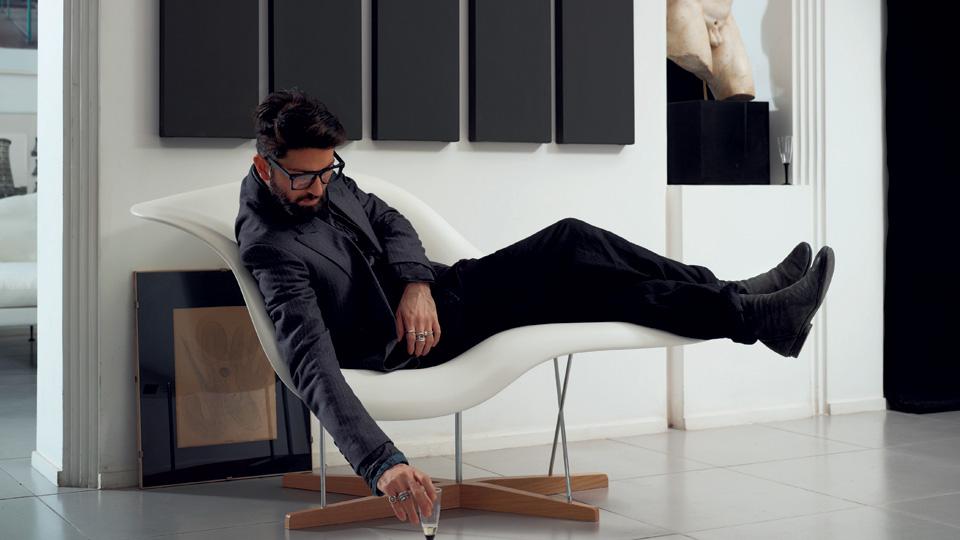FICTION OF SOMETHING
by Florian Böhm
Please go to youtube and watch it
The text spoken is the following:
"Only when things are lost or nowhere to be found they show their faces. Their caliber and sentimental value beyond words becomes revealed. We think they have a shape, a weight, a presence and a name we can rely on them, but things are never what they seem to be. Transition, their core shift whenever dropping off a Radar, objects move. The Valley can keep hold of them for any longer than once and in the end it feels like a split second. Where are they now? Back in the round about of life serving someone else. What do I look for. Just a briefcase with my precious knows to sell left in a moment at a chair at the party yesterday it was that memory itself I lost."
What is this?
Before we dive in this riddle, think for a minute what is your reaction to that? What is this guy talking? What is he looking for? Does he knows what he lost, or did he really lose something? Why this hat and this suspenders? Is it the same guy or who is it then? Is this guy something he is dreaming of, or remembering the same way he does about the party? He gave up to find out what after all he didn't know what it was? How is it possible to have a mind and an occupation which enables the means to have such a nice environment and be so lost up in the air? Is this his house or somebody else's? His parents maybe? Is he living with his parents yet? Or is it just a hangover?
This is actually a catalog for a Vitra line of furniture.
To come up with these 2 minutes furniture catalog (this is what it really is...), take a look on how it was conceived and accomplished:
I will reproduce here what can be seen at Domus, in case it disappears
Vitra Fiction: telling a Vitra story
A conversation
between photographer Florian Böhm and set designer Paolo Bonfini, behind
the scenes of the Vitra Fiction production in Rome, 16 January, 2012.
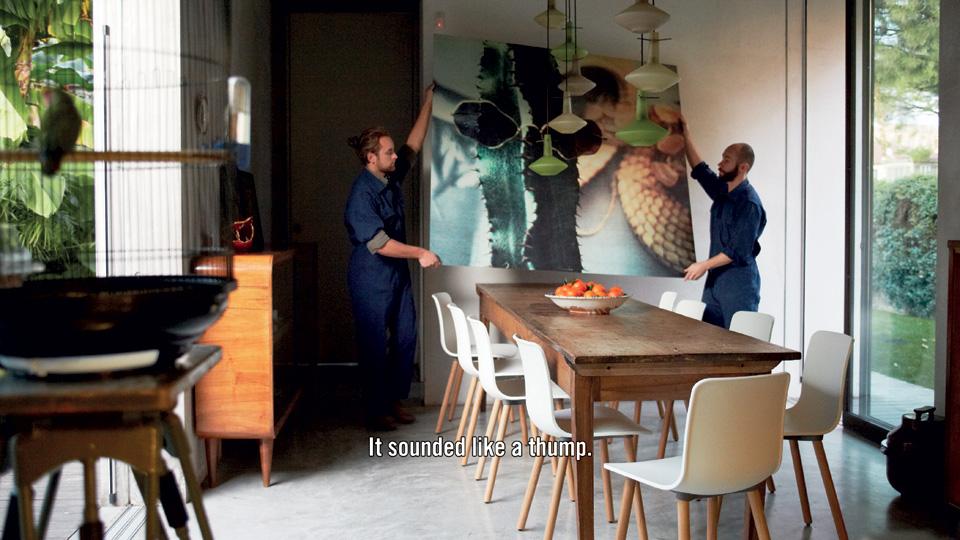
Florian Böhm: Vitra Fiction started by looking at Select&Arrange, Vitra's 2005 catalogue, which was based around a wonderful and, at the time, innovative idea. The catalogue took the reader into places that were real and tried to transmit an idea of what actual homes were like. Yet people tend to get bored by too much reality. Today everyone has a camera, and they take pictures everywhere and any given moment. The aesthetics of this trend are repetitive and nothing surprises us anymore, especially in advertising. In order to bring these spaces back to life, I suggested that we move from reality to fiction and present the furniture as part of a mise-en-scène.
Paolo Bonfini: You brought elements of narration, people and movement into furniture product photography. But why did you go for re-enacted situations through the use of cinematic means and not those linked to documentary?
F. B. Imagine how lucky someone has to be to have a camera at hand and release the shutter at the very second that a glass breaks. We did not have the means for such a feat, so we compromised and decided to approach this whole thing like a movie. A movie triggers our imagination and emotions and even though we know that it has been constructed, if its done well, we tend to believe that it could be real.
P. B.: True. A movie has a
strong narrative structure and a sense of authenticity, while at the same time
being completely staged.
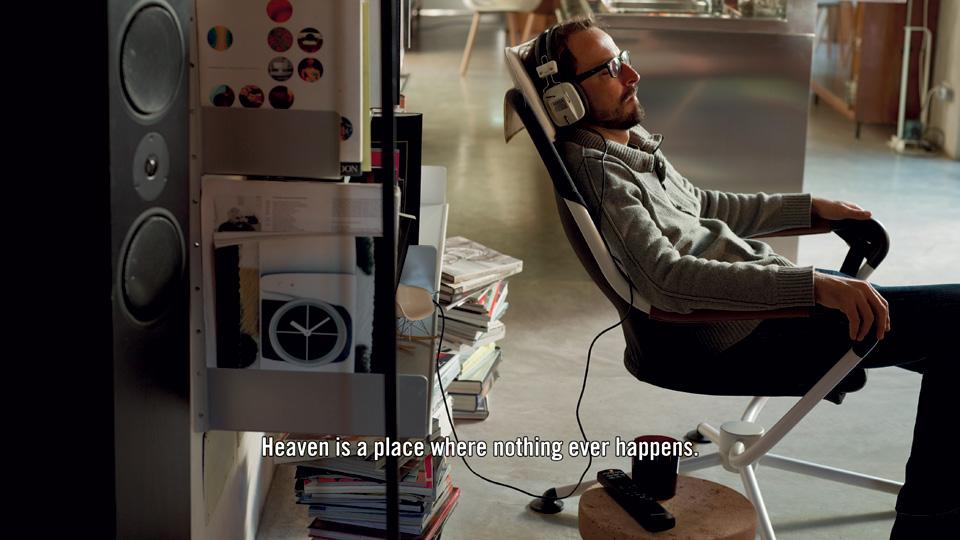
F. B.: It is convincing to the spectator because an actual person is actually doing something. Though technically there are very few differences between photography and filmmaking.
P. B.: The movie camera captures motion, in 24 pictures per second. It means that in 10 seconds you take 240 pictures. In an hour, 14'400... and so on. In photography you might spend an entire day over just one picture. What a difference!
F. B.: Whereas the beauty of filmmaking is that even if you isolate the individual frame you still perceive what you see as something that is part of a story. During the production the work of all the people involved – set design, light, sound, actors... – is concentrated on the story line.
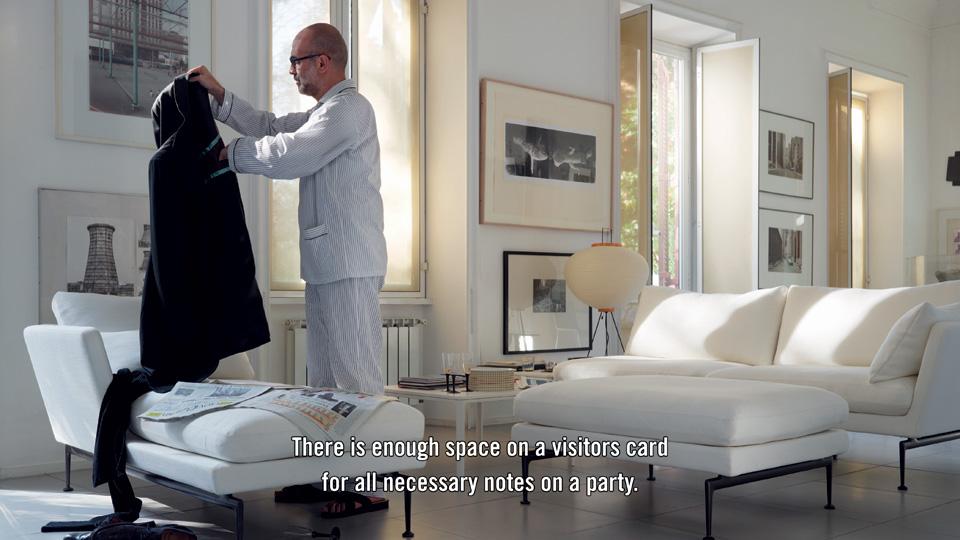
P. B.: It is team work.
F. B.: Thus this narrative quality gets embedded into the aesthetic of a movie screenshot.
P. B.: We shot in six different locations in Rome. Logistics, props and actors had to be organized as if it was an actual movie production, and in the end, it was. You invited me and my crew to do exactly what we do when we work on a movie. But this time something new was triggered, thanks to this different kind of collaboration.
F. B.: The backstage was real. We wanted to tell people's way of living through the little incidents that everyday life is made up of.
P. B.: A life story.
F. B.: A story by Vitra...
P. B.: ... like the scene with the rolling mandarins.
F. B.: You drop something. Either you catch it or you have to get onto your knees to pick it up while it continues to roll under a table. This is simply one of those things that has happened to all of us at some time or another. The choice of scenes is infinite and therefore it is not important to look at what actually happens, as long as what is shown is ordinary enough for anyone to relate to.
-
Usually the story line dictates everything and pieces of furniture are a
means to an end. My work is about showing just enough of something but never
too much
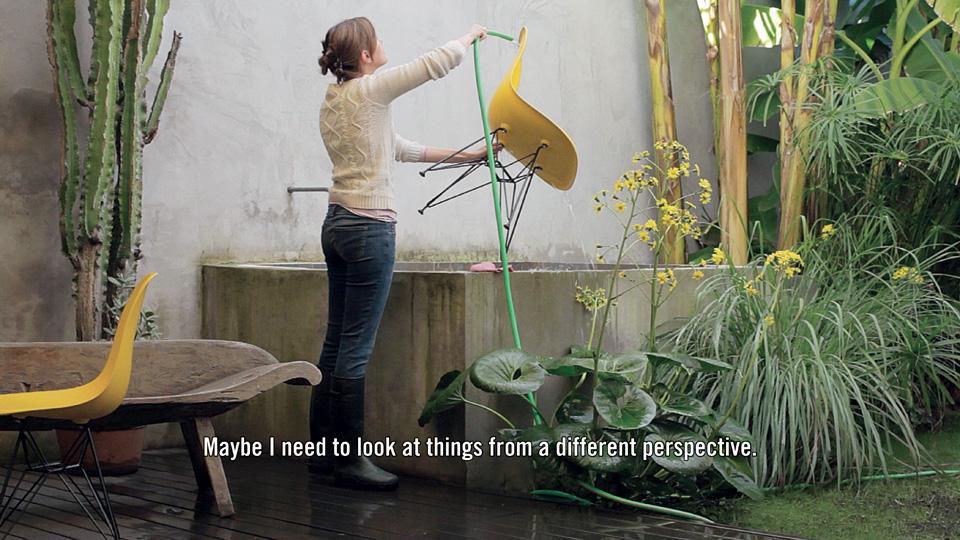
P. B.: Indeed these scenes do not have a beginning, or an end. There is no actual storyline.
F. B.: We don't really know anything about the person in the picture. What you see is just a fleeting moment...
P. B.: And the occasional subtitles don't give a clear answer either.
F. B.: The lines written by Eckhart Nickel are an additional layer to the image. They give clues, but no answers to the context of the scene. On one hand, subtitles come from a long tradition. First silent movies used subtitles because gestures could only say so much. But Federico Fellini liked to use them and he often wrote the dialogue only during post-production.
P. B.: Usually the story line dictates everything and pieces of furniture are a means to an end. My work is about showing just enough of something but never too much. If something distracts the eye of the public away from an actor, you move it a bit further to the side. If I place an object in too prominent a position it is im mediumtely recognized as product placement.

F. B.: For this project it was the exact opposite. Our protagonists were the pieces of furniture themselves, the starring cast.
P. B.: In movies the overall feeling is important. We even have the freedom to use a fake, like a fake carpet or fake wallpaper to turn the scenes alive.
F. B.: Because the video resolution means that you won't be able to see what is really happening. In photography you cannot escape the fact that someone will stop in front of your image and look at it closely blown up on the wall. There is no sound, no movement to distract the viewer. In high resolution things gain in meaning. We have to question every detail to be able to use the movie data also for still images.

P. B.: The frenzy of photography. On a movie set a glass of water is placed on a table. That's it. It is something straightforward and simple and it does not really matter whether the glass is 2 cm to the left or right. What is important is that the glass is about to be picked up and smashed. The main task of a set designer is to maintain a lightness that seems natural, and can even appear to be random. In my line of work it is good to remember that we are not saving lives, we are only making a movie...
F. B.: ...moving pictures...
P. B.: ...or the backstage images of a movie...
F. B.: ...of a non-existent movie about real life...
P. B.: ...and the things that life is made of...
F. B.: ...Vitra Fiction.
